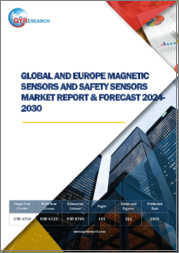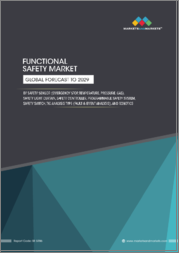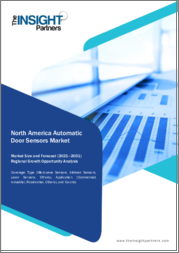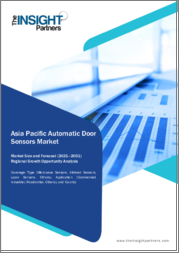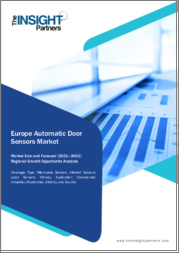
|
시장보고서
상품코드
1722982
세계의 안전 센서 시장 규모, 점유율, 동향, 예측 : 유형별, 센서 유형별, 최종사용자별, 지역별(2025-2033년)Safety Sensors Market Size, Share, Trends and Forecast by Type, Sensor Type, End User, and Region, 2025-2033 |
||||||
안전 센서 세계 시장 규모는 2024년 19억 7,000만 달러에 달했습니다. 향후 IMARC Group은 2033년까지 33억 1,000만 달러에 달하고, 2025-2033년 5.61%의 연평균 복합 성장률(CAGR)을 보일 것으로 예측했습니다. 현재 아시아태평양이 시장을 독점하고 있으며, 2024년에는 35.6% 이상의 높은 시장 점유율을 차지했습니다. 이는 작업 안전을 강화하기 위한 산업 자동화 증가, 각 산업 분야의 엄격한 작업장 안전 규정, 자동차 및 제조 부문의 첨단 안전 솔루션에 대한 수요 증가, IoT 지원 안전 센서의 채택, 작업장 위험 감소에 대한 인식이 높아짐에 따른 것으로 분석됩니다. 안전 센서 시장 점유율을 더욱 높이고 있습니다.
안전 센서는 사고 예방을 위해 기계 및 기타 산업 응용 분야에서 사용되는 모니터링 장치입니다. 환경, 빛의 파장, 포토다이오드 원리, 전자기 신호의 변화에 따라 달라집니다. 장비를 보호하고 인명사고를 방지하기 위한 고품질의 신뢰할 수 있는 비용 효율적인 솔루션입니다. 또한 원격지 및 위험 지역 검사, 기계 성능 향상, 마모 및 손상 감소에도 도움이 됩니다. 그 결과, 엔지니어링, 제조, 식품 가공, 의료, 석유 및 가스, 광업 등 다양한 분야에서 사용되고 있습니다.
안전 센서 시장 동향 :
제조업에서 근로자의 안전에 대한 인식이 높아지는 것은 시장을 주도하는 중요한 요인 중 하나입니다. 또한, 조직에서 고가의 장비 보호에 대한 우려가 증가하고 있습니다. 이는 여러 국가의 정부가 작업장 안전에 대한 엄격한 규제와 함께 시장 성장을 가속하고 있습니다. 또한, 오류, 위치 오차, 도어 개폐 신호를 식별하기 위한 센서에 장착된 진단용 LED에 대한 수요도 증가하고 있습니다. 이와 더불어, 정확하고 정교한 안전 기능을 갖춘 무선 주파수 식별(RFID)을 갖춘 첨단 시스템의 사용이 증가함에 따라 전 세계적으로 안전 센서에 대한 수요가 증가하고 있습니다. 또한, 기계 시스템과 자동화 프로세스의 통합을 통해 모니터링이 용이하고, 폐기물을 줄이고, 생산 속도를 향상시킬 수 있다는 점도 시장에 긍정적인 영향을 미치고 있습니다. 또한, 보다 안전한 운전 경험을 제공하는 자율 주행 자동차의 생산이 확대되고 있으며, 이는 업계 투자자들에게 유리한 성장 기회를 제공합니다. 또한, 주요 시장 기업들은 지리적 확장, 제품 출시 및 승인에 주력하고 있으며, 이는 전체 매출과 수익성을 촉진할 것으로 예측됩니다.
본 보고서에서 다룬 주요 질문
- 안전 센서 시장 규모는?
- 안전 센서 시장 전망은?
- 안전 센서 시장을 이끄는 주요 요인은?
- 안전 센서 시장에서 가장 큰 점유율을 차지하는 지역은?
- 세계 안전 센서 시장의 주요 기업은?
목차
제1장 서문
제2장 조사 범위와 조사 방법
- 조사 목적
- 이해관계자
- 데이터 소스
- 1차 정보
- 2차 정보
- 시장 추정
- 보텀업 접근
- 톱다운 접근
- 조사 방법
제3장 주요 요약
제4장 서론
- 개요
- 주요 업계 동향
제5장 세계의 안전 센서 시장
- 시장 개요
- 시장 실적
- COVID-19의 영향
- 시장 예측
제6장 시장 분석 : 유형별
- 안전 라이트 커튼
- 안전 레이저 스캐너
- 안전 매트
- 세이프티 엣지
- 기타
제7장 시장 분석 : 센서 유형별
- 가속도계
- 바이오센서
- 이미지 센서
- 모션 검출기
- 기타
제8장 시장 분석 : 최종사용자별
- 의약품
- 식품 및 음료
- 자동차
- 기타
제9장 시장 분석 : 지역별
- 북미
- 미국
- 캐나다
- 아시아태평양
- 중국
- 일본
- 인도
- 한국
- 호주
- 인도네시아
- 기타
- 유럽
- 독일
- 프랑스
- 영국
- 이탈리아
- 스페인
- 러시아
- 기타
- 라틴아메리카
- 브라질
- 멕시코
- 기타
- 중동 및 아프리카
- 시장 내역 : 국가별
제10장 SWOT 분석
- 개요
- 강점
- 약점
- 기회
- 위협
제11장 밸류체인 분석
제12장 Porter의 Five Forces 분석
- 개요
- 바이어의 교섭력
- 공급 기업의 교섭력
- 경쟁 정도
- 신규 진출업체의 위협
- 대체품의 위협
제13장 가격 분석
제14장 경쟁 구도
- 시장 구조
- 주요 기업
- 주요 기업 개요
- ABB Ltd
- Autonics Corporation
- Balluff GmbH
- Banner Engineering Corporation
- Contrinex AG
- Keyence Corporation
- Leuze electronic GmbH+Co. KG
- Omron Corporation
- Panasonic Corporation
- Pilz GmbH & Co. KG
- Rockwell Automation Inc.
- Schneider Electric SE
The global safety sensors market size was valued at USD 1.97 Billion in 2024. Looking forward, IMARC Group estimates the market to reach USD 3.31 Billion by 2033, exhibiting a CAGR of 5.61% from 2025-2033. Asia Pacific currently dominates the market, holding a significant market share of over 35.6% in 2024 driven by the increasing industrial automation to enhance operational safety, stringent workplace safety regulations across industries, and rising demand for advanced safety solutions in automotive and manufacturing sectors. The adoption of IoT-enabled safety sensors and growing awareness about reducing workplace hazards further propelling the safety sensors market share.
Safety sensors are monitoring devices used in machines and other industrial applications to prevent accidents. They rely on the environment, wavelength of light, and the photodiode principle and changes in electromagnetic signals. They are high-quality, dependable, and cost-effective solutions for safeguarding equipment and preventing personal injuries. They also aid in examining remote and hazardous areas and improving the performance of the machine and reducing its wear and tear. As a result, they find extensive applications in engineering, manufacturing, food processing, medical, and oil, gas and mining.
Safety Sensors Market Trends:
The growing awareness for the safety of workers in the manufacturing industry represents one of the key factors driving the market. Moreover, there is a rise in concerns about the protection of high-cost equipment in organizations. This, along with stringent regulations imposed by governments of several countries for safety at the workplace, is bolstering the growth of the market. In addition, there is an increase in the demand for diagnostic light-emitting diodes (LEDs) on the sensors to identify errors, misalignment, and door open and closed signaling. This, coupled with the rising utilization of advanced systems with radio frequency identification (RFID) for accurate and advanced safety features, is catalyzing the demand for safety sensors worldwide. Besides this, the integration of mechanical systems with automated processes to provide effortless monitoring, waste reduction, and increase the speed of production is positively influencing the market. Additionally, the growing production of autonomous vehicles for a safer driving experience is offering lucrative growth opportunities to industry investors. Furthermore, key market players are focusing on geographical expansions and product launches and approvals, which are projected to propel their overall sales and profitability.
Key Market Segmentation:
Breakup by Type:
- Safety Light Curtain
- Safety Laser Scanner
- Safety Mat
- Safety Edge
- Others
Breakup by Sensor Type:
- Accelerometers
- Biosensors
- Image Sensors
- Motion Detectors
- Others
Breakup by End User:
- Pharmaceutical
- Food and Beverage
- Automotive
- Others
Breakup by Region:
- North America
- United States
- Canada
- Asia-Pacific
- China
- Japan
- India
- South Korea
- Australia
- Indonesia
- Others
- Europe
- Germany
- France
- United Kingdom
- Italy
- Spain
- Russia
- Others
- Latin America
- Brazil
- Mexico
- Others
- Middle East and Africa
Competitive Landscape:
The competitive landscape of the industry has also been examined along with the profiles of the key players being ABB Ltd, Autonics Corporation, Balluff GmbH, Banner Engineering Corporation, Contrinex AG, Keyence Corporation, Leuze electronic GmbH + Co. KG, Omron Corporation, Panasonic Corporation, Pilz GmbH & Co. KG, Rockwell Automation Inc. and Schneider Electric SE.
Key Questions Answered in This Report
- 1.How big is the safety sensors market?
- 2.What is the future outlook of safety sensors market?
- 3.What are the key factors driving the safety sensors market?
- 4.Which region accounts for the largest safety sensors market share?
- 5.Which are the leading companies in the global safety sensors market?
Table of Contents
1 Preface
2 Scope and Methodology
- 2.1 Objectives of the Study
- 2.2 Stakeholders
- 2.3 Data Sources
- 2.3.1 Primary Sources
- 2.3.2 Secondary Sources
- 2.4 Market Estimation
- 2.4.1 Bottom-Up Approach
- 2.4.2 Top-Down Approach
- 2.5 Forecasting Methodology
3 Executive Summary
4 Introduction
- 4.1 Overview
- 4.2 Key Industry Trends
5 Global Safety Sensors Market
- 5.1 Market Overview
- 5.2 Market Performance
- 5.3 Impact of COVID-19
- 5.4 Market Forecast
6 Market Breakup by Type
- 6.1 Safety Light Curtain
- 6.1.1 Market Trends
- 6.1.2 Market Forecast
- 6.2 Safety Laser Scanner
- 6.2.1 Market Trends
- 6.2.2 Market Forecast
- 6.3 Safety Mat
- 6.3.1 Market Trends
- 6.3.2 Market Forecast
- 6.4 Safety Edge
- 6.4.1 Market Trends
- 6.4.2 Market Forecast
- 6.5 Others
- 6.5.1 Market Trends
- 6.5.2 Market Forecast
7 Market Breakup by Sensor Type
- 7.1 Accelerometers
- 7.1.1 Market Trends
- 7.1.2 Market Forecast
- 7.2 Biosensors
- 7.2.1 Market Trends
- 7.2.2 Market Forecast
- 7.3 Image Sensors
- 7.3.1 Market Trends
- 7.3.2 Market Forecast
- 7.4 Motion Detectors
- 7.4.1 Market Trends
- 7.4.2 Market Forecast
- 7.5 Others
- 7.5.1 Market Trends
- 7.5.2 Market Forecast
8 Market Breakup by End User
- 8.1 Pharmaceutical
- 8.1.1 Market Trends
- 8.1.2 Market Forecast
- 8.2 Food and Beverage
- 8.2.1 Market Trends
- 8.2.2 Market Forecast
- 8.3 Automotive
- 8.3.1 Market Trends
- 8.3.2 Market Forecast
- 8.4 Others
- 8.4.1 Market Trends
- 8.4.2 Market Forecast
9 Market Breakup by Region
- 9.1 North America
- 9.1.1 United States
- 9.1.1.1 Market Trends
- 9.1.1.2 Market Forecast
- 9.1.2 Canada
- 9.1.2.1 Market Trends
- 9.1.2.2 Market Forecast
- 9.1.1 United States
- 9.2 Asia-Pacific
- 9.2.1 China
- 9.2.1.1 Market Trends
- 9.2.1.2 Market Forecast
- 9.2.2 Japan
- 9.2.2.1 Market Trends
- 9.2.2.2 Market Forecast
- 9.2.3 India
- 9.2.3.1 Market Trends
- 9.2.3.2 Market Forecast
- 9.2.4 South Korea
- 9.2.4.1 Market Trends
- 9.2.4.2 Market Forecast
- 9.2.5 Australia
- 9.2.5.1 Market Trends
- 9.2.5.2 Market Forecast
- 9.2.6 Indonesia
- 9.2.6.1 Market Trends
- 9.2.6.2 Market Forecast
- 9.2.7 Others
- 9.2.7.1 Market Trends
- 9.2.7.2 Market Forecast
- 9.2.1 China
- 9.3 Europe
- 9.3.1 Germany
- 9.3.1.1 Market Trends
- 9.3.1.2 Market Forecast
- 9.3.2 France
- 9.3.2.1 Market Trends
- 9.3.2.2 Market Forecast
- 9.3.3 United Kingdom
- 9.3.3.1 Market Trends
- 9.3.3.2 Market Forecast
- 9.3.4 Italy
- 9.3.4.1 Market Trends
- 9.3.4.2 Market Forecast
- 9.3.5 Spain
- 9.3.5.1 Market Trends
- 9.3.5.2 Market Forecast
- 9.3.6 Russia
- 9.3.6.1 Market Trends
- 9.3.6.2 Market Forecast
- 9.3.7 Others
- 9.3.7.1 Market Trends
- 9.3.7.2 Market Forecast
- 9.3.1 Germany
- 9.4 Latin America
- 9.4.1 Brazil
- 9.4.1.1 Market Trends
- 9.4.1.2 Market Forecast
- 9.4.2 Mexico
- 9.4.2.1 Market Trends
- 9.4.2.2 Market Forecast
- 9.4.3 Others
- 9.4.3.1 Market Trends
- 9.4.3.2 Market Forecast
- 9.4.1 Brazil
- 9.5 Middle East and Africa
- 9.5.1 Market Trends
- 9.5.2 Market Breakup by Country
- 9.5.3 Market Forecast
10 SWOT Analysis
- 10.1 Overview
- 10.2 Strengths
- 10.3 Weaknesses
- 10.4 Opportunities
- 10.5 Threats
11 Value Chain Analysis
12 Porters Five Forces Analysis
- 12.1 Overview
- 12.2 Bargaining Power of Buyers
- 12.3 Bargaining Power of Suppliers
- 12.4 Degree of Competition
- 12.5 Threat of New Entrants
- 12.6 Threat of Substitutes
13 Price Analysis
14 Competitive Landscape
- 14.1 Market Structure
- 14.2 Key Players
- 14.3 Profiles of Key Players
- 14.3.1 ABB Ltd
- 14.3.1.1 Company Overview
- 14.3.1.2 Product Portfolio
- 14.3.1.3 Financials
- 14.3.1.4 SWOT Analysis
- 14.3.2 Autonics Corporation
- 14.3.2.1 Company Overview
- 14.3.2.2 Product Portfolio
- 14.3.3 Balluff GmbH
- 14.3.3.1 Company Overview
- 14.3.3.2 Product Portfolio
- 14.3.4 Banner Engineering Corporation
- 14.3.4.1 Company Overview
- 14.3.4.2 Product Portfolio
- 14.3.5 Contrinex AG
- 14.3.5.1 Company Overview
- 14.3.5.2 Product Portfolio
- 14.3.6 Keyence Corporation
- 14.3.6.1 Company Overview
- 14.3.6.2 Product Portfolio
- 14.3.6.3 Financials
- 14.3.7 Leuze electronic GmbH + Co. KG
- 14.3.7.1 Company Overview
- 14.3.7.2 Product Portfolio
- 14.3.8 Omron Corporation
- 14.3.8.1 Company Overview
- 14.3.8.2 Product Portfolio
- 14.3.8.3 Financials
- 14.3.8.4 SWOT Analysis
- 14.3.9 Panasonic Corporation
- 14.3.9.1 Company Overview
- 14.3.9.2 Product Portfolio
- 14.3.9.3 Financials
- 14.3.9.4 SWOT Analysis
- 14.3.10 Pilz GmbH & Co. KG
- 14.3.10.1 Company Overview
- 14.3.10.2 Product Portfolio
- 14.3.11 Rockwell Automation Inc.
- 14.3.11.1 Company Overview
- 14.3.11.2 Product Portfolio
- 14.3.11.3 Financials
- 14.3.11.4 SWOT Analysis
- 14.3.12 Schneider Electric SE
- 14.3.12.1 Company Overview
- 14.3.12.2 Product Portfolio
- 14.3.12.3 Financials
- 14.3.12.4 SWOT Analysis
- 14.3.1 ABB Ltd









